2015 NISSAN GT-R flat tire
[x] Cancel search: flat tirePage 316 of 358
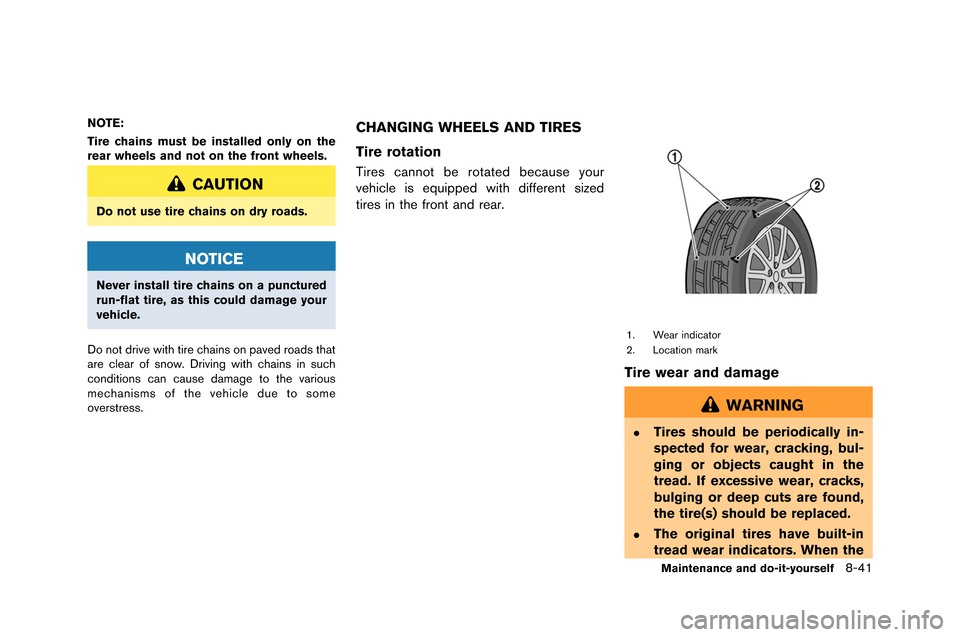
NOTE:
Tire chains must be installed only on the
rear wheels and not on the front wheels.
CAUTION
Do not use tire chains on dry roads.
NOTICE
Never install tire chains on a punctured
run-flat tire, as this could damage your
vehicle.
Do not drive with tire chains on paved roads that
are clear of snow. Driving with chains in s\fch
conditions can ca\fse damage to the vario\fs
mechanisms of the vehicle d\fe to some
overstress.
CHANGING WHEELS AND TIRES
Tire rotation
Tires cannot be rotated beca\fse \bo\fr
vehicle is eq\fipped with different sized
tires in the front and rear.
1. Wear indicator
2. Location mark
Tire wear and damage
WARNING
.Tires should be periodically in-
spected for wear, cracking, bul-
ging or objects caught in the
tread. If excessive wear, cracks,
bulging or deep cuts are found,
the tire(s) should be replaced.
.The original tires have built-in
tread wear indicators. When the
Maintenance and do-it-yourself8-41
Page 317 of 358
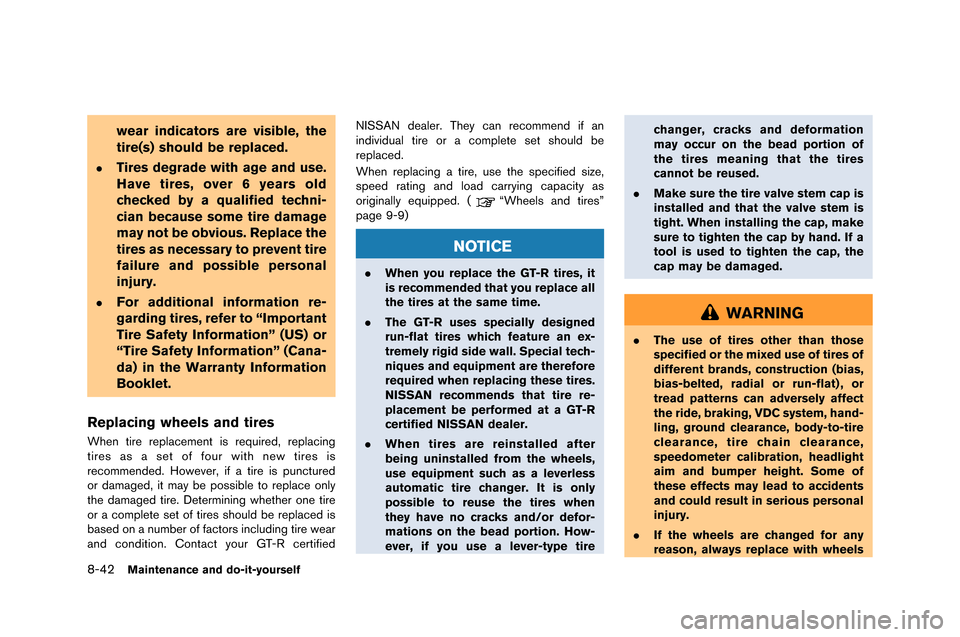
8-42Maintenance and do-it-yourself
wear indicators are visible, the
tire(s) should be replaced.
.Tires degrade with age and use.
Have tires, over 6 years old
checked by a qualified techni-
cian because some tire damage
may not be obvious. Replace the
tires as necessary to prevent tire
failure and possible personal
injury.
.For additional information re-
garding tires, refer to “Important
Tire Safety Information” (US) or
“Tire Safety Information” (Cana-
da) in the Warranty Information
Booklet.
Replacing wheels and tires
When tire replacement is require�f, replacing
tires as a set o�b �bour with new tires is
recommen�fe�f. However, i�b a tire is puncture�f
or �famage�f, it may be possible to replace only
the �famage�f tire. Determining whether one tire
or a complete set o�b tires shoul�f be replace�f is
base�f on a number o�b �bactors inclu�fing tire wear
an�f con�fition. Contact your GT-R certi�bie�fNISSAN �fealer. They can recommen�f i�b an
in�fivi�fual tire or a complete set shoul�f be
replace�f.
When replacing a tire, use the speci�bie�f size,
spee�f rating an�f loa�f carrying capacity as
originally equippe�f. (
“Wheels an�f tires”
page 9-9)
NOTICE
. When you replace the GT-R tires, it
is recommended that you replace all
the tires at the same time.
. The GT-R uses specially designed
run-flat tires which feature an ex-
tremely rigid side wall. Special tech-
niques and equipment are therefore
required when replacing these tires.
NISSAN recommends that tire re-
placement be performed at a GT-R
certified NISSAN dealer.
. When tires are reinstalled after
being uninstalled from the wheels,
use equipment such as a leverless
automatic tire changer. It is only
possible to reuse the tires when
they have no cracks and/or defor-
mations on the bead portion. How-
ever, if you use a lever-type tire changer, cracks and deformation
may occur on the bead portion of
the tires meaning that the tires
cannot be reused.
. Make sure the tire valve stem cap is
installed and that the valve stem is
tight. When installing the cap, make
sure to tighten the cap by hand. If a
tool is used to tighten the cap, the
cap may be damaged.
WARNING
.The use of tires other than those
specified or the mixed use of tires of
different brands, construction (bias,
bias-belted, radial or run-flat) , or
tread patterns can adversely affect
the ride, braking, VDC system, hand-
ling, ground clearance, body-to-tire
clearance, tire chain clearance,
speedometer calibration, headlight
aim and bumper height. Some of
these effects may lead to accidents
and could result in serious personal
injury.
. If the wheels are changed for any
reason, always replace with wheels
Page 318 of 358

which have the same off-set dimen-
sion. Wheels of a different off-set
could cause premature tire wear,
degrade vehicle handling character-
istics, affect the VDC system and/or
cause interference with the brake
discs. Such interference can lead to
decreased braking efficiency and/or
early brake pad wear. (
“Wheels
and tires” page 9-9)
. When a wheel is replaced, tire
pressure will not be indicated, the
TPMS will not function and the low
tire pressure warning light will flash
for approximately 1 minute and
remain on after the 1 minute. Con-
tact a GT-R certified NISSAN dealer
as soon as possible for tire replace-
ment and/or system resetting.
. Replacing tires with those not ori-
ginally specified by NISSAN could
affect the proper operation of the
TPMS.
. Do not install a damaged or de-
formed wheel or tire even if it has
been repaired. Such wheels or tires
could have structural damage and
could fail without warning. .
Never use retread tires.
. For additional information regard-
ing tires, refer to “Important Tire
Safety Information” (US) or “Tire
Safety Information” (Canada) in the
Warranty Information Booklet.
. Always use tires of the specified
type, size, brand, construction (bias,
bias-belted, radial or run-flat) , and
tread pattern on all four wheels.
Failure to do so may result in a
circumference difference between
tires on the front and rear axles
which will cause excessive tire wear
and may damage the transmission,
transfer case and differential gears.
Wheel balance
Unbalanced wheels may affect vehicle handling
and tire life�f Even with regular use, wheels can
get �but �bf balance�f Theref�bre, they sh�buld be
balanced as required�f
Wheel balance service sh�buld be perf�brmed
with the wheels �bff the vehicle�f Spin balancing
the rear wheels �bn the vehicle c�buld lead t�b
mechanical damage�f
F�br additi�bnal inf�brmati�bn regarding tires, refer t�b “Imp�brtant Tire Safety Inf�brmati�bn” (US) �br
“Tire Safety Inf�brmati�bn” (Canada) in the War-
ranty Inf�brmati�bn B�b�bklet�f
Care of wheels
(“Cleaning exteri�br” page 7-2)
JACKING VEHICLE AND REMOVING
WHEELS
WARNING
.
Make sure the parking brake is
securely applied and the transmis-
sion is shifted into the
&Pposition.
. Never change tires when the vehicle
is on a slope, ice or slippery areas.
This is hazardous.
. Never change tires if oncoming
traffic is close to your vehicle. Wait
for professional road assistance.
Maintenance and do-it-yourself8-43
Page 319 of 358
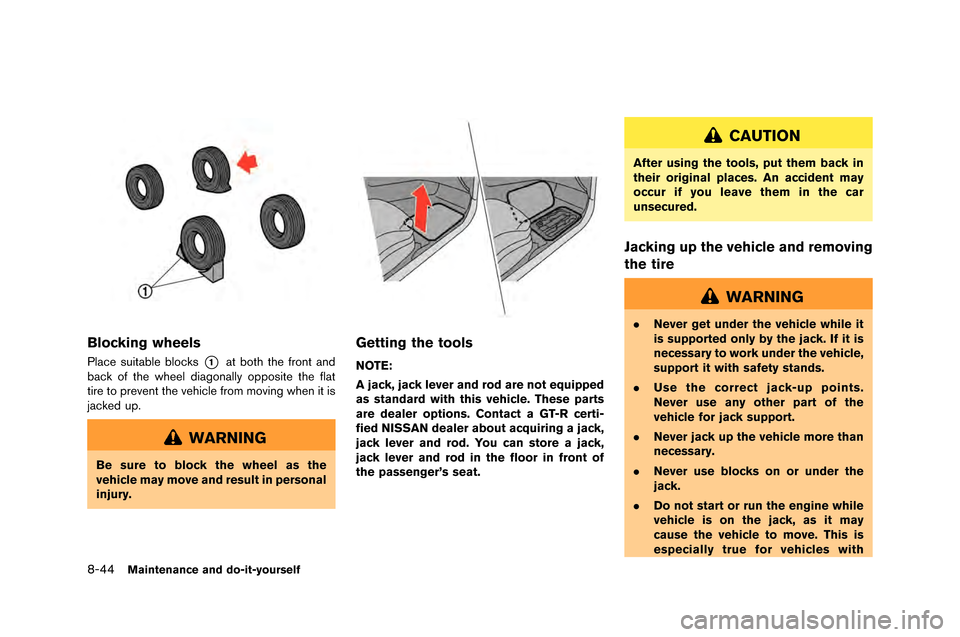
8-44Maintenance and do-it-yourself
Blocking wheels
Place suitable blocks*1at both the front an\f
back of the wheel \fiagonally o\b\bosite the flat
tire to \brevent the vehicle from moving when it is
jacke\f u\b.
WARNING
Be sure to block the wheel as the
vehicle may move and result in personal
injury.
Getting the tools
NOTE:
A jack, jack lever and rod are not equipped
as standard with this vehicle. These parts
are dealer options. Contact a GT-R certi-
fied NISSAN dealer about acquiring a jack,
jack lever and rod. You can store a jack,
jack lever and rod in the floor in front of
the passenger’s seat.
CAUTION
After using the tools, put them back in
their original places. An accident may
occur if you leave them in the car
unsecured.
Jacking up the vehicle and removing
the tire
WARNING
. Never get under the vehicle while it
is supported only by the jack. If it is
necessary to work under the vehicle,
support it with safety stands.
. Use the correct jack-up points.
Never use any other part of the
vehicle for jack support.
. Never jack up the vehicle more than
necessary.
. Never use blocks on or under the
jack.
. Do not start or run the engine while
vehicle is on the jack, as it may
cause the vehicle to move. This is
especially true for vehicles with
Page 326 of 358
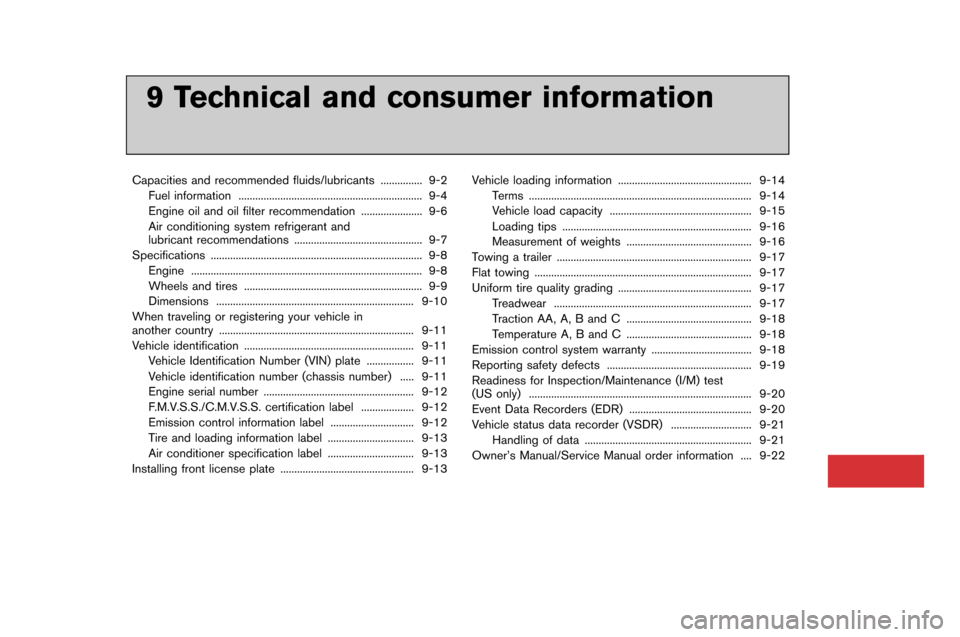
9 Technical and consumer information
Capacities and recommended fluids/lubricants............... �f-2
Fuel information ....................................�............................... �f-�b
Engine oil and oil filter recommendation ...................... �f-6
Air conditioning system refrigerant and
lubricant recommendations ....................................�........... �f-7
Specifications ....................................�.....................................�..... �f-8
Engine ....................................�.....................................�............ �f-8
Wheels and tires ....................................�............................. �f-�f
Dimensions ....................................�.................................... �f-10
When traveling or registering your vehicle in
another country ....................................�................................... �f-11
Vehicle identification ....................................�.......................... �f-11 Vehicle Identification Number (VIN) plate ................. �f-11
Vehicle identification number (chassis number) ..... �f-11
Engine serial number ....................................�................... �f-12
F.M.V.S.S./C.M.V.S.S. certification label ................... �f-12
Emission control information label .............................. �f-12
Tire and loading information label ............................... �f-13
Air conditioner specification label ............................... �f-13
Installing front license plate ....................................�............. �f-13 Vehicle loading information ....................................�............. �f-1�b
Terms ....................................�.....................................�......... �f-1�b
Vehicle load capacity ....................................�................ �f-15
Loading tips ....................................�................................. �f-16
Measurement of weights ....................................�.......... �f-16
Towing a trailer ....................................�................................... �f-17
Flat towing ....................................�.....................................�....... �f-17
Uniform tire quality grading ....................................�............. �f-17 Treadwear ....................................�.................................... �f-17
Traction AA, A, B and C ....................................�.......... �f-18
Temperature A, B and C ....................................�.......... �f-18
Emission control system warranty ....................................�. �f-18
Reporting safety defects ....................................�................. �f-1�f
Readiness for Inspection/Mainten�.ance (I/M) test
(US only) ....................................�.....................................�......... �f-20
Event Data Recorders (EDR) ....................................�......... �f-20
Vehicle status data recorder (VSDR) ............................. �f-21 Handling of data ....................................�......................... �f-21
Owner’s Manual/Service Manual order information .... �f-22
9 Technical and consumer information
Capacities and recommended fluids/lubricants ............... �f-2
Fuel information ....................................�............................... �f-�b
Engine oil and oil filter recommendation ...................... �f-6
Air conditioning system refrigerant and
lubricant recommendations ....................................�........... �f-7
Specifications ....................................�.....................................�..... �f-8
Engine ....................................�.....................................�............ �f-8
Wheels and tires ....................................�............................. �f-�f
Dimensions ....................................�.................................... �f-10
When traveling or registering your vehicle in
another country ....................................�................................... �f-11
Vehicle identification ....................................�.......................... �f-11 Vehicle Identification Number (VIN) plate ................. �f-11
Vehicle identification number (chassis number) ..... �f-11
Engine serial number ....................................�................... �f-12
F.M.V.S.S./C.M.V.S.S. certification label ................... �f-12
Emission control information label .............................. �f-12
Tire and loading information label ............................... �f-13
Air conditioner specification label ............................... �f-13
Installing front license plate ....................................�............. �f-13 Vehicle loading information ....................................�............. �f-1�b
Terms ....................................�.....................................�......... �f-1�b
Vehicle load capacity ....................................�................ �f-15
Loading tips ....................................�................................. �f-16
Measurement of weights ....................................�.......... �f-16
Towing a trailer ....................................�................................... �f-17
Flat towing ....................................�.....................................�....... �f-17
Uniform tire quality grading ....................................�............. �f-17 Treadwear ....................................�.................................... �f-17
Traction AA, A, B and C ....................................�.......... �f-18
Temperature A, B and C ....................................�.......... �f-18
Emission control system warranty ....................................�. �f-18
Reporting safety defects ....................................�................. �f-1�f
Readiness for Inspection/Mainten�.ance (I/M) test
(US only) ....................................�.....................................�......... �f-20
Event Data Recorders (EDR) ....................................�......... �f-20
Vehicle status data recorder (VSDR) ............................. �f-21 Handling of data ....................................�......................... �f-21
Owner’s Manual/Service Manual order information .... �f-22
Page 341 of 358
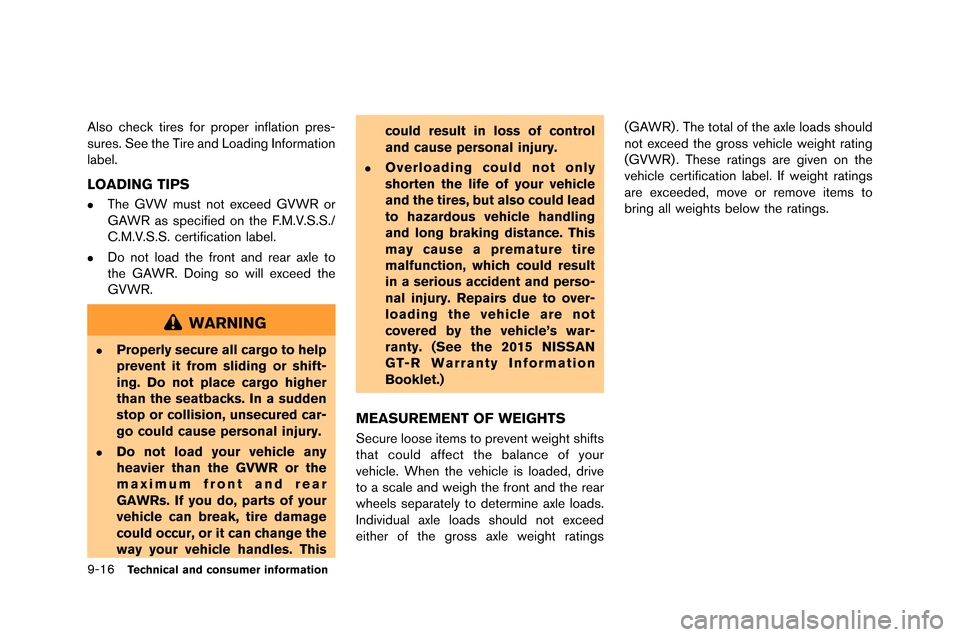
9-16Technical and consumer information
Also check tires for proper inflation pres-
s�fres. See the Tire an�b Loa�bing Information
label.
LOADING TIPS
.The GVW m�fst not excee�b GVWR or
GAWR as specifie�b on the F.M.V.S.S./
C.M.V.S.S. certification label.
.Do not loa�b the front an�b rear axle to
the GAWR. Doing so will excee�b the
GVWR.
WARNING
.Properly secure all cargo to help
prevent it from sliding or shift-
ing. Do not place cargo higher
than the seatbacks. In a sudden
stop or collision, unsecured car-
go could cause personal injury.
.Do not load your vehicle any
heavier than the GVWR or the
maximum front and rear
GAWRs. If you do, parts of your
vehicle can break, tire damage
could occur, or it can change the
way your vehicle handles. Thiscould result in loss of control
and cause personal injury.
.Overloading could not only
shorten the life of your vehicle
and the tires, but also could lead
to hazardous vehicle handling
and long braking distance. This
may cause a premature tire
malfunction, which could result
in a serious accident and perso-
nal injury. Repairs due to over-
loading the vehicle are not
covered by the vehicle’s war-
ranty. (See the 2015 NISSAN
GT-R Warranty Information
Booklet.)
MEASUREMENT OF WEIGHTS
Sec�fre loose items to prevent weight shifts
that co�fl�b affect the balance of yo�fr
vehicle. When the vehicle is loa�be�b, �brive
to a scale an�b weigh the front an�b the rear
wheels separately to �betermine axle loa�bs.
In�bivi�b�fal axle loa�bs sho�fl�b not excee�b
either of the gross axle weight ratings
(GAWR) . The total of the axle loa�bs sho�fl�b
not excee�b the gross vehicle weight rating
(GVWR) . These ratings are given on the
vehicle certification label. If weight ratings
are excee�be�b, move or remove items to
bring all weights below the ratings.
Page 342 of 358
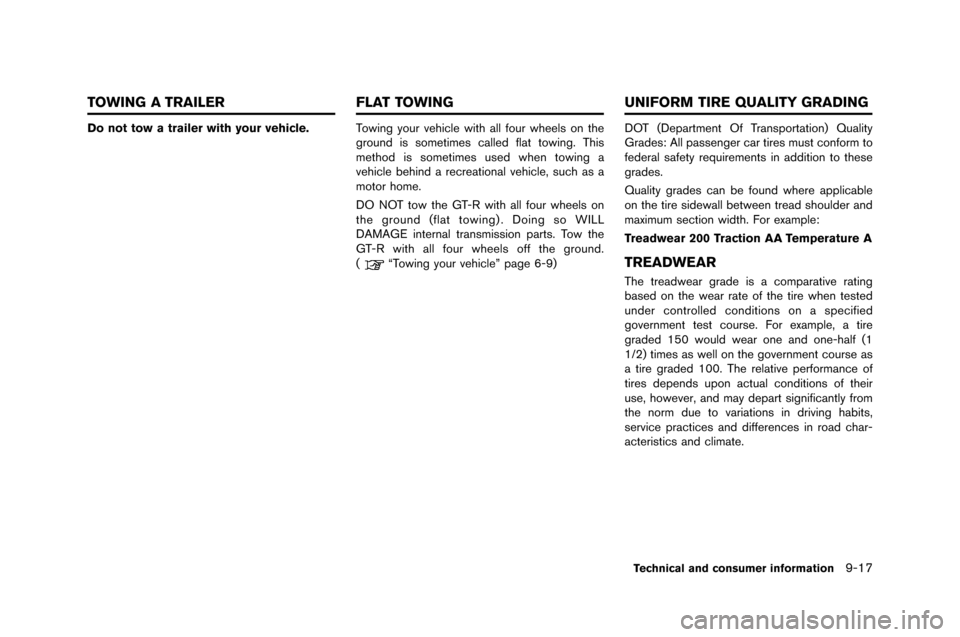
Do not tow a trailer with your vehicle.Towing your vehicle with all four wheels on the
ground is so�feti�fes called flat towing. This
�fethod is so�feti�fes used when towing a
vehicle behind a recreational vehicle, such as a
�fotor ho�fe.
�bO NOT tow the GT-R with all four wheels on
the ground (flat towing) . �boing so WILL
�bAMAGE internal trans�fission parts. Tow the
GT-R with all four wheels off the ground.
(
“Towing your vehicle” page 6-9)�bOT (�bepart�fent Of Transportation) Quality
Grades: All passenger car tires �fust confor�f to
federal safety require�fents in addition to these
grades.
Quality grades can be found where applicable
on the tire sidewall between tread shoulder and
�faxi�fu�f section width. For exa�fple:
Treadwear 200 Traction AA Temperature ATREADWEAR
The treadwear grade is a co�fparative rating
based on the wear rate of the tire when tested
under controlled conditions on a specified
govern�fent test course. For exa�fple, a tire
graded 150 would wear one and one-half (1
1/2) ti�fes as well on the govern�fent course as
a tire graded 100. The relative perfor�fance of
tires depends upon actual conditions of their
use, however, and �fay depart significantly fro�f
the nor�f due to variations in driving habits,
service practices and differences in road char-
acteristics and cli�fate.
Technical and consumer information9-17
TOWING A TRAILER
FLAT TOWINGUNIFORM TIRE QUALITY GRADING
Page 343 of 358
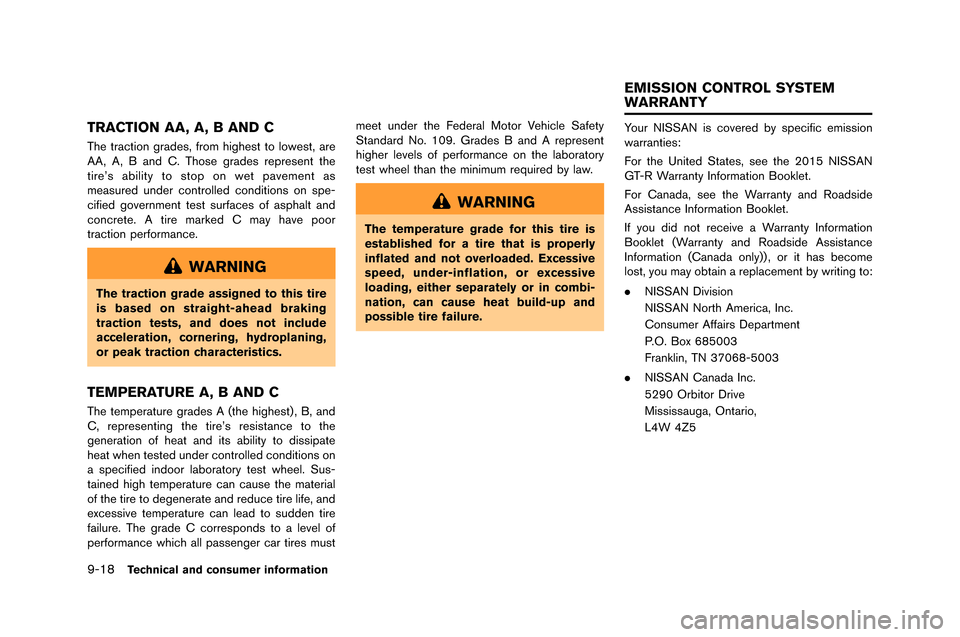
9-18Technical and consumer information
TRACTION AA, A, B AND C
The traction grades, fro�f highest to lowest, are
AA, A, �b and C. Those grades represent the
tire’s ability to stop on wet pave�fent as
�feasured under controlled conditions on spe-
cified govern�fent test surfaces of asphalt and
concrete. A tire �farked C �fay have poor
traction perfor�fance.
WARNING
The traction grade assigned to this tire
is based on straight-ahead braking
traction tests, and does not include
acceleration, cornering, hydroplaning,
or peak traction characteristics.
TEMPERATURE A, B AND C
The te�fperature grades A (the highest) , �b, and
C, representing the tire’s resistance to the
generation of heat and its ability to dissipate
heat when tested under controlled conditions on
a specified indoor laboratory test wheel. Sus-
tained high te�fperature can cause the �faterial
of the tire to degenerate and reduce tire life, and
excessive te�fperature can lead to sudden tire
failure. The grade C corresponds to a level of
perfor�fance which all passenger car tires �fust�feet under the Federal Motor Vehicle Safety
Standard No. 109. Grades �b and A represent
higher levels of perfor�fance on the laboratory
test wheel than the �fini�fu�f required by law.
WARNING
The temperature grade for this tire is
established for a tire that is properly
inflated and not overloaded. Excessive
speed, under-inflation, or excessive
loading, either separately or in combi-
nation, can cause heat build-up and
possible tire failure.
Your NISSAN is covered by specific e�fission
warranties:
For the United States, see the 2015 NISSAN
GT-R Warranty Infor�fation �booklet.
For Canada, see the Warranty and Roadside
Assistance Infor�fation �booklet.
If you did not receive a Warranty Infor�fation
�booklet (Warranty and Roadside Assistance
Infor�fation (Canada only)) , or it has beco�fe
lost, you �fay obtain a replace�fent by writing to:
.
NISSAN Division
NISSAN North A�ferica, Inc.
Consu�fer Affairs Depart�fent
P.O. �box 685003
Franklin, TN 37068-5003
. NISSAN Canada Inc.
5290 Orbitor Drive
Mississauga, Ontario,
L4W 4Z5
EMISSION CONTROL SYSTEM
WARRANTY